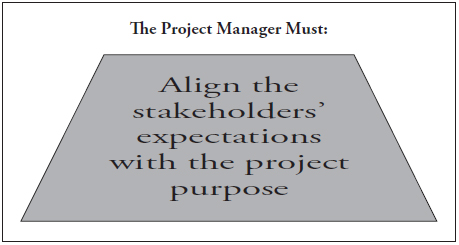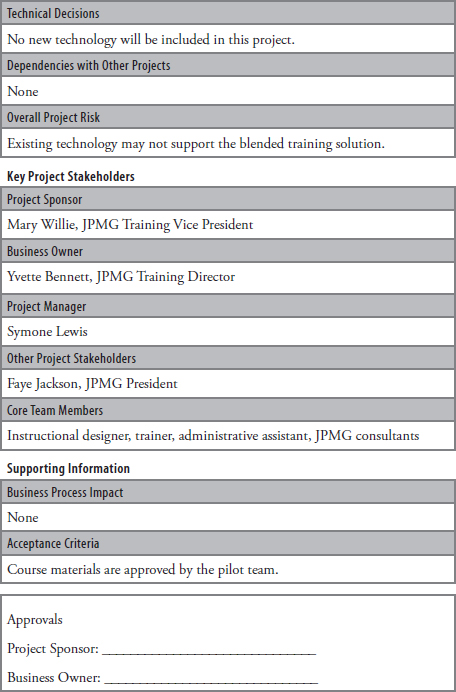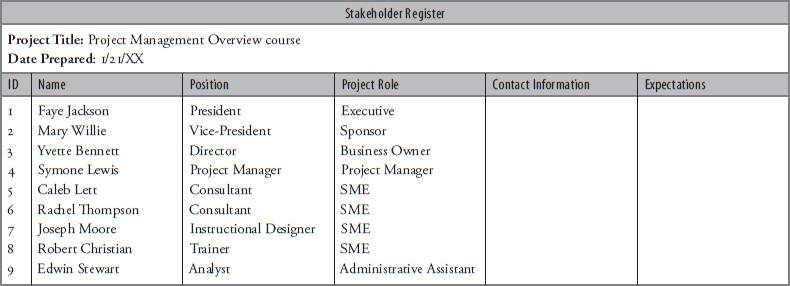6  Initiating
Initiating
Getting the project off to a good start is important. The initiating process allows the project manager to quickly gain an understanding of the project by defining project objectives, scope, assumptions, constraints, and risk factors. It is also important at this time for the project manager to develop a relationship with the project sponsor and to discuss project management expectations. Even small projects have unique project management needs; for example, by determining stakeholder management needs, the project manager can ensure that all stakeholders are engaged at the appropriate time throughout the project. The initiation process provides accountability and allows organizational resources to be applied to the project.
For the purposes of the SPM process, it is assumed that the decision to launch the project has already been made, the staffing has been approved, funding exists, and the project manager has been assigned. Preproject documents like the project request, requirements overview, and project proposal have already been completed. Simple projects do not require this level of formality; as soon as the assignment is given, the initiating activities begin.
Initiating Process Summary
The PMBOK® Guide, sixth edition, defines the initiating process group as comprising “those processes that are performed to define a new project or a new phase of an existing project by obtaining authorization to start the project or phase.”1 In summary, they are the activities conducted to start up the project.

The first thing the project manager needs to do after being assigned responsibility for a project is to obtain the preproject documents and identify the project stakeholders. The project manager then interviews the project sponsor and stakeholders to get the information required for developing the project charter. The project charter provides structure for the project manager to use to obtain the additional information needed to plan the project. The project manager prepares the project charter and reviews it with the project sponsor and customer to ensure they are all in agreement. At the end of the initiating process, the project manager is ready to plan the project.
Initiating Process Steps
The following are the initiating process steps:
1. Obtain copies of preproject documents.
2. Identify project stakeholders.
3. Interview project sponsor and other stakeholders.
4. Prepare project charter.
5. Identify assumptions and constraints.
6. Review project charter with stakeholders.
7. Obtain approval from project sponsor to begin planning.

Step 1: Obtain Copies of Preproject Documents
The project manager should obtain copies of all preproject documents. Preproject documents were discussed in chapter 4 and could include, but are not limited to, the project business case, project benefits management plan, statement of work, and project request. These documents will differ depending on an organization’s project selection and approval methodology. That methodology may include the use of a project approval committee and a categorization of project types. The project type will need to be included in the project charter because it will be used later by the project approval committee to help establish the project’s priority. Many small projects are not assigned as part of a project selection methodology; they are simply given as assignments. If this is the case, the project manager should obtain any documents that supply background information for the project.
Step 2: Identify Project Stakeholders
The project manager will need to identify project stakeholders—the people, groups, or organizations that could impact or be impacted by a decision, activity, or outcome of the project. The project manager should identify and document information regarding the project stakeholders’ interest, involvement, and influence on the project. It is important to identify the appropriate focus for each stakeholder so his or her expectations can be managed accordingly.
The project sponsor is the key project stakeholder and shares responsibility for project success. The project sponsor has ultimate sign-off authority for the project and for small projects is often the key decision maker. Other project stakeholders may include primary customers, secondary customers, and the project team.
Step 3: Interview Project Sponsor and Other Stakeholders
The project manager should begin to establish a relationship with the project stakeholders. As these relationships are being established, the project manager should be building trust and understanding the stakeholders’ needs and expectations. It is not enough just to know the stakeholders’ needs and expectations; the project manager must respond appropriately to those needs and expectations. It is essential for the project manager to build a solid foundation of trust with the project stakeholders. See chapter 3 for more discussion on trust.
Trust
Ways to build trust:
• Tell the truth.
• Be consistent.
• Maintain confidences.
• Demonstrate competence.
A key activity during the initiation phase is information gathering. The project manager must determine the stakeholders’ needs and clarify their expectations. This is the time to identify what the stake-holders really want. The project manager should talk to people with expert judgment. This means obtaining information from technical and business subject matter experts. Ways to gather information include reviewing existing documentation, conducting interviews, distributing surveys, and observing the current operation. After the project manager has completed the information-gathering process, the information should be documented and shared with the project stakeholders.
Step 4: Prepare the Project Charter
The project charter describes the project and serves as an agreement between the sponsor and the project manager. The project manager prepares this document with direction from the project sponsor and input from the customer. The components of the project charter are discussed in the next section.
Step 5: Identify Assumptions and Constraints
An assumption is “a factor in the planning process that is considered to be true, real, or certain, without proof or demonstration.”2
A constraint is a limiting factor that affects the execution of a project or process.3 An assumption log is a project document used to record all assumptions and constraints throughout the project life cycle. The project manager should begin identifying and tracking assumptions and constraints during the initiation phase.
Step 6: Review Project Charter with Stakeholders
The project manager distributes the initial draft of the project charter to key stakeholders to obtain feedback and build consensus. After the project manager receives their input, the project manager updates the project charter and distributes it to the appropriate stakeholders for buy-in.
Step 7: Obtain Approval from Project Sponsor to Begin Planning
The final initiating process step is to obtain approval from the project sponsor.
After all the key project stakeholders have reviewed the project charter and provided input, the project manager shares the project charter with the project sponsor. If the project sponsor approves the project charter, the project manager can begin planning the project activities.
Project Charter
The project manager prepares the project charter with input from the project sponsor. The purpose of the project charter is to provide the project manager with the authority to apply organizational resources to project activities. The project charter provides a link to the ongoing work of the organization and also provides a line of sight from the strategic objective to the project objective. For small projects, the project charter provides a line of sight from the business unit (divisional or departmental) objectives to the project objectives.
The project charter is one of the most important documents in the SPM process because it identifies the project objectives and defines the project scope. The project charter is used as a reference throughout the project to ensure that the project scope does not change. A signed project charter signifies agreement on the work involved and resources committed to deliver the product, service, or result. For small projects, the project charter should be signed by the project sponsor, customer, and project manager.
The deliverable from the initiating process is the project charter or an abbreviated version of the project charter, depending on the size of the project. Two versions of the project charter are covered in this chapter, the project charter and the project charter lite.
The Project Charter
The project charter has the following functions:
• Formally authorizes the project
• Documents the business needs
• Requires sponsor approval
• Is the basis for scope changes
• Provides a line of sight from the business-unit objectives (divisional or departmental) to the project objectives
Project Charter Components
The project charter includes the following:
• Project Description
![]() Background information—Provide an overview of the purpose of the project and the business goals the project will support.
Background information—Provide an overview of the purpose of the project and the business goals the project will support.
![]() Project objectives—State what the project will achieve. The project objectives define the business need or opportunity. The objectives should be SMART—specific, measurable, attainable/achievable, realistic, and time-bound.
Project objectives—State what the project will achieve. The project objectives define the business need or opportunity. The objectives should be SMART—specific, measurable, attainable/achievable, realistic, and time-bound.
![]() Project scope—The scope identifies the boundaries of the project by stating what will be done and what will not be done.
Project scope—The scope identifies the boundaries of the project by stating what will be done and what will not be done.
![]() In Scope—Identify what is included in this project.
In Scope—Identify what is included in this project.
![]() Not in Scope—Identify what is known not to be part of this project. (This is also known as an exclusion.)
Not in Scope—Identify what is known not to be part of this project. (This is also known as an exclusion.)
![]() Project budget—Identify the funding needed for this project and funding source, if applicable.
Project budget—Identify the funding needed for this project and funding source, if applicable.
![]() Milestone summary—Milestones are significant events in the project. Identify the milestones and their respective beginning or completion timeframes. These are estimated timeframes; specific dates will be identified during planning.
Milestone summary—Milestones are significant events in the project. Identify the milestones and their respective beginning or completion timeframes. These are estimated timeframes; specific dates will be identified during planning.
• Project Information
![]() High-level deliverables—List the major deliverables to be completed as part of the project.
High-level deliverables—List the major deliverables to be completed as part of the project.
![]() Assumptions—Assumptions are factors that for planning purposes are considered true, real, or certain. These events or conditions must occur for the project to be successful, but at this time they are not certain. Clearly and concisely state assumptions so everyone knows the premise on which the charter is based.
Assumptions—Assumptions are factors that for planning purposes are considered true, real, or certain. These events or conditions must occur for the project to be successful, but at this time they are not certain. Clearly and concisely state assumptions so everyone knows the premise on which the charter is based.
![]() Constraints—Constraints are restrictions that affect the performance of the project or factors that affect when an activity can be scheduled.
Constraints—Constraints are restrictions that affect the performance of the project or factors that affect when an activity can be scheduled.
![]() Technical decisions—Identify any technical decisions that may impact the project.
Technical decisions—Identify any technical decisions that may impact the project.
![]() Dependencies with other projects—Identify links with other projects.
Dependencies with other projects—Identify links with other projects.
![]() Overall project risk—Identify uncertain events or conditions that if they occur could have a negative or positive impact on the project. This can also be used to document the risk level for the project.
Overall project risk—Identify uncertain events or conditions that if they occur could have a negative or positive impact on the project. This can also be used to document the risk level for the project.
• Key Project Stakeholders
![]() Project sponsor—Identify person with ultimate responsibility for the project.
Project sponsor—Identify person with ultimate responsibility for the project.
![]() Project manager—Identify project manager and roles and responsibilities.
Project manager—Identify project manager and roles and responsibilities.
![]() Other project stakeholders—List other project stakeholders, including the customer or end user of the outcomes of the project.
Other project stakeholders—List other project stakeholders, including the customer or end user of the outcomes of the project.
![]() Core team members—Identify key team members.
Core team members—Identify key team members.
• Supporting Information
![]() Business process impact—Note whether any existing business processes will have to change or whether new business processes will have to be developed.
Business process impact—Note whether any existing business processes will have to change or whether new business processes will have to be developed.
![]() Acceptance criteria—Explain how you will know that the project is considered complete and successful.
Acceptance criteria—Explain how you will know that the project is considered complete and successful.
• Project Charter Approvals
![]() Project sponsor
Project sponsor
![]() Customer
Customer
PROJECT CHARTER EXAMPLE
Symone Lewis, as the project manager for the project management training project (from chapter 4), reviewed the preproject documents, which consisted of the statement of work and project request. She then identified? the project stakeholders and scheduled a meeting to discuss the project charter. During the meeting, Symone interviewed the project stakeholders and obtained the high-level deliverables, assumptions, constraints, and known risks. Symone then developed the project charter (figure 6.1) and the assumption log (figure 6.2).
Symone shared the project charter with the project sponsor, Yvette Bennett, and obtained approval. Symone is ready to begin the planning activities.
Project Charter Lite Components
An abbreviated charter, referred to in this book as a project charter lite, can be used for simple projects—for example, short-term projects that do not have a financial impact. For simple projects, the initiation process is meant to be quick. The project manager prepares the project charter and reviews it with the project sponsor and customer to ensure they are all in agreement. Agreement at this point is informal, usually verbal; however, it is a good idea for the project manager to provide a copy of the project charter to the project sponsor and customer for their records. At the end of the initiating process, the project manager is ready to plan the project.
The project charter lite consists of the following:
• Project objectives—State what the project will achieve. The project objectives define the business need or opportunity.
• Stakeholders—Identify the persons who are actively involved in the project. They include the project sponsor, project manager, and any key stakeholders.
Project Charter


Figure 6.1: Project charter
Asumption Log

Figure 6.2: Asumption Log
Project Charter as Basis for Scope Change
A project team was developing a website for the organization. During one of the team meetings, the team identified additional features that would really enhance the appearance of the website. The project manager immediately referenced the project charter and realized that the additional features were not part of the original scope. Although these additional features could enhance the final product, just adding them at will would have been bad for the project. Uncontrolled scope changes can cause any project to be late or go over budget. The correct response is to do change control, identify the impact of adding the new features, and obtain approval from the sponsor.
• Project scope—Specify what is included and what is not included in the project.
• Major deliverables—State the major results, goods, or services that will be produced as part of the project.
• Assumptions—Identify factors that are considered true, real, or certain.
• Constraints—Identify restrictions that limit project options.
• Risk factors—Identify potential problems that could affect the project.
• Dependencies with other projects—Identify links to other projects.
• Acceptance criteria—Explain how you will know that the project is considered complete and successful.
PROJECT CHARTER LITE EXAMPLE
At the beginning of May, the training director, Yvette Bennett, gave consultant Herman Edwards an assignment to prepare a project management process presentation. This half-day presentation would be given to existing clients free of charge and would serve as a marketing tool for the upcoming project management course.
Herman wanted to be clear about the assignment, so the first thing he did was develop a project charter lite, shown in figure 6.3.
Project Roles and Responsibilities
The project manager must identify the project stakeholders at the beginning of the project. In addition to the project manager, the project stakeholders for small projects usually include the project sponsor, customer, and project team. The project manager should define roles and responsibilities for the project stakeholders and obtain their buy-in.
Clarifying expectations at the beginning of the project makes it easier to manage expectations throughout the project. Small projects in particular need to have roles and responsibilities communicated because team members will be working on other projects or operational activities and might not intuitively know their project responsibilities or the short timeframe in which they must occur. Also, with small teams there might not be a backup resource, and lack of communication could result in a project delay.
Small projects usually do not require a steering committee or oversight committee. These committees consist of high-level organizational leaders who represent the decision-making bodies that provide direction for the course of a project. For small projects the project sponsor is normally all that is required to make key project decisions and determine the project direction.
Sponsor
The sponsor initiates the project and is responsible for its overall success. The project sponsor serves as the project champion and provides financial resources, approves project plans, and is responsible for removing organizational barriers that might impede project progress. For small projects the project sponsor may be the project manager’s direct supervisor. Small projects can also be interdepartmental, in which case the project sponsor may be the director in charge of the division.
Project Charter Lite

Figure 6.3: Project charter lite
Customer
The customer is the person who will use the outcomes of the project, whether internal or external to the organization. For small projects the sponsor and the customer might be the same person. If the sponsor and customer are not the same person, it is important to engage the customer in the initiating process. The customer is responsible for providing input during the planning phase, contributing to problem-solving and decision-making efforts, and taking ownership of the final product.
Project Manager
The project manager is responsible for achieving the project objectives. The project manager decides on the project management process components, documents the project requirements, prepares the project charter, plans the project activities, monitors project progress, communicates with all project stakeholders, captures and uses lessons learned, and manages change. Project manager might not be the person’s formal title, although this person will assume the project manager’s responsibilities as defined in the SPM project methodology.
Project Team
A team is two or more people who share a common goal and work in a cooperative effort to get a common job done. More specifically, the team members work together to complete the project deliverables. Small projects might have five or fewer team members who are considered part-time resources on the project. Team members are sometimes referred to as subject matter experts. The project team should use the defined approach and processes, adapted to comply with project requirements, to meet stakeholder needs and expectations.
Stakeholder Register
The stakeholder register is used to identify the people impacted by the project. This document includes relevant information about each stakeholder and can be updated as the project progresses.

Figure 6.4: Stakeholder Register
STAKEHOLDER REGISTER EXAMPLE
Continuing with the Project Management Overview course project example, Symone identified the project stakeholders and developed the stakeholder register shown in figure 6.4.
![]()
LEADERSHIP CONNECTION
Leadership activities that occur during the initiation phase include:
• Create and nurture the project vision. If project management is typically not used on small projects, the project manager can provide the vision of using project management for small projects and motivate others to use the project management process and tools.
• Map the project objective to the business goal.
• Secure project resources.
• Identify project stakeholders and set expectations.
• Define the roles and responsibilities of project team members.
• Set up communications. The project manager must determine how often, by what means, and with which stakeholders to communicate.
• Gather project information through a series of surveys, questionnaires, interviews, review of outcomes from previous projects, and observation of current operations. Information gathering is a key activity because it allows the project manager to determine the project needs, identify project stakeholders, and clarify expectations.
![]()
KEYS FOR INITIATING SUCCESS
Keys for initiating success include:
• Engage project stakeholders early in the process and keep them engaged throughout the life of the project.
• Establish trust.
• Remember that the project charter sets the stage for the planning phase and should include input from all key stakeholders.
• Obtain necessary approvals before proceeding.
Initiating Process Guide
Description
Initiating defines and authorizes the project or a project phase.
Purpose
The purpose of project initiating is to perform the activities necessary to start up the project.
Inputs
• Business documents
• Statement of work
• Project request
• Project proposal
Tools and Techniques
• Project charter instructions
• Project charter template
• Project charter lite template
• Assumption log template
• Stakeholder register template
Outputs
• Project charter or project charter lite
• Assumption log
• Stakeholder register
Procedures
1. Obtain copies of preproject documents.
2. Identify project stakeholders.
3. Interview project sponsor and other stakeholders.
4. Prepare project charter.
5. Identify assumptions and constraints.
6. Identify project stakeholders.
7. Review project charter with stakeholders.
8. Obtain approval from project sponsor to begin planning.
